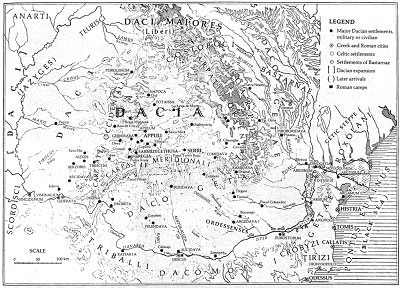The Dacian Wars were wars of revenge for the Romans under Trajan, a way to undo the humiliation suffered in88-89 AD. For the Dacians (especially for King Decebalus) these wars were a way to gain even more glory.

In Rome the decadent rule of Domitian was starting to get on the nerves of the Roman senate and the Army was also sick of Domitian, especially due to the recent defeat in Dacia. In 96 AD Domitian was murdered by his own bodyguards (The Praetorian Guard). The Senate along with the Army soon put the elderly Nerva in power.Nerva knew his time in office would be short and proclaimed Marcus Ulipus Trajanus his successor. In 96 ADNerva died and [i]Trajan (as he is now known) was proclaimed Emperor. Trajan was a brilliant military commander and the Army loved him (a good thing in the world of messy Roman politics).
In Dacia the popularity of Decebalus was continuing to grow more and more. Decebalus (who was a nobleman) arose to power when he led Dacian forces in what they perceived to be a great victory but was really a tie atTaepae during Domitain’s campaign in to Dacia. King Duras saw this and abdicated the throne, because Durashad no children the people elected Decebalus as King. Interestingly Decebalus is not the man’s real name, his real name was Diurapneus, but in the eyes of the people he was Decebalus, the Dacian Braveheart and Wolf.
In 99 AD Trajan marched into Rome on foot (a sign of humility) and decided as his first military action as Emperor to invade Dacia, primarily to end the humiliating subsidy to Decebalus that Domitian set up. First however Trajan spent some time building a huge wall in Brittain to keep the pesky Celtic tribes at bay. In 101 AD Trajan was finally ready to invade Dacia and set out with 150,000 soldiers. Trajan starts off his invasion with the building of bridges across the Danube River. Decebalus begins his defense by fleeing in front of the Romans and burning all land behind. Decebalus hoped that when the rations of the Roman Army ran out they would turn back. Trajan had managed to figure out Decebalus’ strategy and marched slowly and deliberately building roads and fortifications as he went. Decebalus and Trajan meet in battle for the first time at Taepae(this is the same place that Decebalus rose to fame in Domitian’s campaign in 88-89 AD) before the famous “Iron Gates”. The Romans had many causalities in this battle and so did the Dacians, in the end this battle ofTaepae ended in a draw. Decebalus decided to turn to the south and raid Roman settlements, in the middle of winter. With a huge army 140,000 along with 20,000 allied soldiers Decebalus raided or destroyed Roman settlements in Lower Moesia and all along the coast of the Pontus Euxinus (modern Black Sea). Trajan, upon hearing this marches south to confront the Dacians and their allies, eventually pushing them back after a long campaign. In the spring of 102 AD Trajan returns to Dacia and pursues the Dacians with new vigor. Trajantravels a different route through Dacia this time following the Aluta (modern Oltu) River. The rate that the Romans are advancing worries Decebalus and he sends two emissaries to Trajan, the first is right out rejected the second is admitted an audience with Trajan’s Praetorian prefect, but the negotiations go nowhere. Trajansoon crosses through the Carpathian Mountains and reaches the plains on the other side. The Army is then spilt into two parts with one part securing the foothills and the rest marching on the Dacian capital ofSarmizegetusa. Decebalus surrenders soon after the Romans capture his sister. The peace treaty was soon signed and consisted of: submitting to Rome, surrender of captured siege engines, return of Roman deserters, and become a client king. Though the stain and shame of Domitian’s defeat is erased from Roman memory andTrajan is bestowed the title of Dacius (Conqueror of Dacia) the Kingdom of Dacia was still intact.
In 105 AD Decebalus began to prepare to go to war again to defeat the Romans and take back lost territory. The war began when Decebalus launched attacks on the Iazyges (Sarmatian allies of Rome) and captured or burned nearly all Roman forts in Dacia. Trajan began to make preparations to crush the Dacian revolt but an assassination attempt on his life stopped him. Trajan marched to Drobreata and spent nearly all of 105 ADrepulsing the Dacian attempts to dislodge him. In 106 AD Trajan begins the counterattack against the Dacians conquering each part of the country piece by piece making slow but steady progress. Eventually Trajan reaches the plain outside Sarmisegetuza. Trajan committed his most veteran legions to the assault among them are: 2nd Legion “Adriutix”, 4th Legion “Flavia Felix”, and a vexillatio (detachment) from 6th Legion “Ferrata”. The first few assaults on Sarmisegetuza where repulsed by the Dacian defenders, but the Romans soon cut off the water supply to Sarmisegetuza. The Romans then used flaming rocks in their catapults and soon set the city on fire, killing Venzia the old high priest of Dacia. Decebalus and most of the Dacian Army managed to escape the city, however the entire Dacian treasury is lost to the Romans when they find the treasury in a cave near the river Sargetia. Decebalus and the Dacian Army made its last stand at Porolissum (modern Moigrad). After his defeat at Porolissum Decebalus flees and the Roman cavalry pursues him. Preferring death to captureDecebalus kills himself along with his officers. Trajan now summarily annexes Dacia into the Roman Empire and begins to send Roman colonists into the country, establishing a permanent Roman presence in the region.

